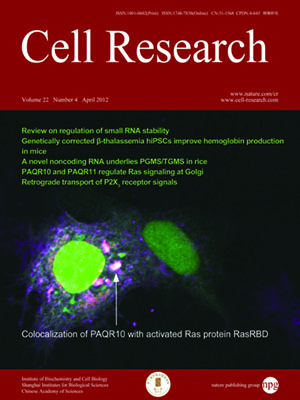
Volume 22, No 4, Apr 2012
ISSN: 1001-0602
EISSN: 1748-7838 2018
impact factor 17.848*
(Clarivate Analytics, 2019)
Volume 22 Issue 4, April 2012: 728-745
ORIGINAL ARTICLES
Differing and isoform-specific roles for the formin DIAPH3 in plasma membrane blebbing and filopodia formation
Jana Stastna1, Xiaoyu Pan1, Haicui Wang2, Alina Kollmannsperger2, Stefan Kutscheidt1, Volker Lohmann3, Robert Grosse2 and Oliver T Fackler1
1Department of Infectious Diseases, Virology, University Hospital Heidelberg, INF 324, 69120 Heidelberg, Germany;
2Institute of Pharmacology, Biochemical Pharmacological Center, University of Marburg, Karl-von-Frisch-Strasse 1, 35032 Marburg, Germany;
3Department of Infectious Diseases, Molecular Virology, University Hospital Heidelberg, INF 345, 69120 Heidelberg, Germany
Correspondence: Oliver T Fackler,(oliver.fackler@med.uni-heidelberg.de)
Plasma membrane (PM) blebs are dynamic actin-rich cell protrusions that occur, e.g., during cytokinesis, amoeboid cell motility and cell attachment. Using a targeted siRNA screen against 21 actin nucleation factors, we identify a novel and essential role of the human diaphanous formin DIAPH3 in PM blebbing during cell adhesion. Suppression of DIAPH3 inhibited blebbing to promote rapid cell spreading involving β1-integrin. Multiple isoforms of DIAPH3 were detected on the mRNA and protein level of which isoforms 3 and 7 were the largest and most abundant isoforms that however did not induce formation of actin-rich protrusions. Rather, PM blebbing specifically involved the low abundance isoform 1 of DIAPH3 and activation of isoform 7 by deletion of the diaphanous-autoregulatory domain caused the formation of filopodia. Dimerization and actin assembly activity were essential for induction of specific cell protrusions by DIAPH3 isoforms 1 and 7. Our data suggest that the N-terminal region comprising the GTPase-binding domain determined the subcellular localization of the formin as well as its protrusion activity between blebs and filopodia. We propose that isoform-selective actin assembly by DIAPH3 exerts specific and differentially regulated functions during cell adhesion and motility.
Cell Research (2012) 22:728-745. doi:10.1038/cr.2011.202; published online 20 December 2011
FULL TEXT | PDF
Browse 2153


